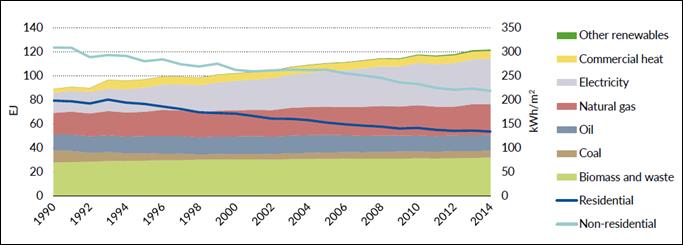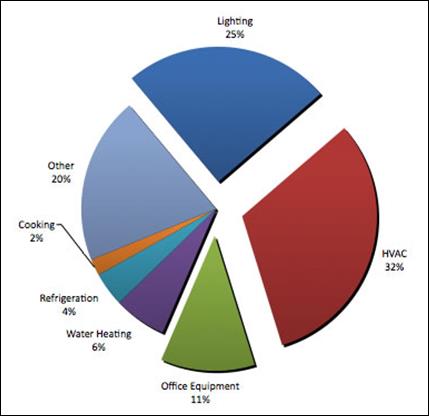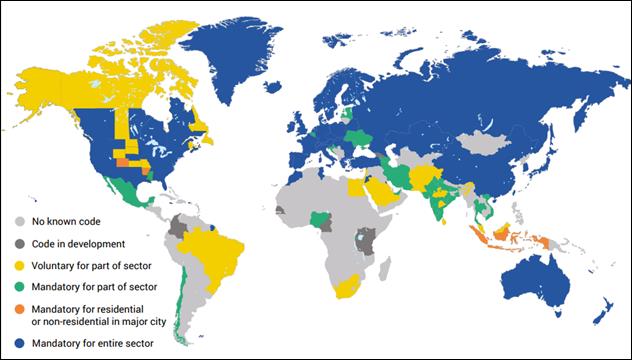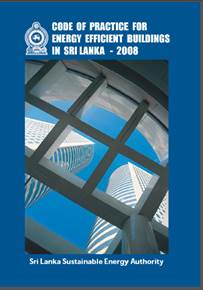BUILDING ENERGY STANDARDS/CODES: PRESENT STATUS AND WAY FORWARD FOR SRI LANKA
By Eng. (Dr.) R M P S BandaraEng. (Prof.) R A Attalage
Background
Buildings account for the consumption of nearly 36% of the global energy supply, 16% of the world’s fresh water and 25% of the forest timber while emitting almost 40% of carbon dioxide gas annually. According to the International Energy Agency, global building sector has consumed 122 EJ (equivalent to 34 x 106 GWh) in 2014. Figure 1 shows the energy consumption and intensity by subsector in the global building sector from 1990 to 2014.

Figure 1: Global building sector energy consumption and intensity by subsector, 1990-2014
Source: International Energy Agency (2016)
According to the United States Energy Information Administration, end-user energy consumption in buildings may increase by an average of 1.5% per annum from 2012 to 2040. In this context, energy utilization in the residential sector may account for nearly 13% of the global end-user energy consumption in 2040. Furthermore, as reported by the Global Alliance for Buildings and Construction, buildings have also accounted for 50% of the global electricity demand, with electrical energy consumption increasing by more than 500% in certain regions of the world since 1990. The report further states that, if appropriate action is not taken in order to improve the energy performance of buildings, energy demand in the global building sector could increase by another 50% by 2050. Moreover, it is observed that approximately 80% of the said growth takes place in developing countries and emerging economies, where there are plenty of opportunities for improving the energy performance of buildings. The built environment is booming in Asia with China constructing almost half of the world’s new buildings. Records show that buildings in Asia are consuming more energy and producing more Green House Gas (GHG) emissions and it is predicted that this will rise at a rapid rate during the next decade. In this present context, high emphasis is placed on optimizing energy performance of buildings and minimizing carbon footprint related to the same. The best approach that can be recommended in order to accomplish this objective is to promote the concept of energy efficiency in buildings.
Lighting, Heating, Ventilating & Air Conditioning (HVAC), and office equipment consume a major portion of energy in a typical commercial building as shown in Figure 2. Most savings can be achieved by implementing energy efficiency measures around the said elements. High-impact measures can significantly reduce energy consumption and cost.

Figure 2: End-use energy consumed by components in a typical commercial building
Source: Building Energy Data Book, US Department of Energy, 2006
Building Energy Standards/Codes
Building energy standards have been introduced mainly for the purpose of establishing the regulatory minimum level for building energy performance. They also offer a level playing field for relevant stakeholders and ensure the elimination of non-conforming products and systems. Building energy standards/codes, which are either of mandatory or voluntary nature have played an important role in building regulations. At present, building energy standards have been established and adopted by many countries irrespective of whether they are in the developed or developing world. Figure 3 shows the present status of building energy codes in the global scenario.
 Figure 3: Building energy codes adopted by country, state and province
Figure 3: Building energy codes adopted by country, state and province
Source: International Energy Agency (2017)
Building energy standards/codes fall into two generic categories: prescriptive and performance-based. In the prescriptive category, the standards stipulate minimum and prescriptive criteria for generic building elements, equipment and energy supply conditions to be complied by the user. This includes building envelope, HVAC equipment, lighting system, service water system, power supply and auxiliary equipment. In case of performance-based standards, the compliance is based on stipulated performance metrics that have to be established by pre-determined methods. This approach mainly utilizes design tools and building performance modelling techniques. Modelling in the performance-based approach considers estimation of peak (generally) design loads, lighting and receptacle power allowance calculations, estimation of annual energy consumption, parametric analyses and energy efficiency measures.
Sri Lankan Scenario
The Sri Lankan commercial and industrial sector comprises a large stock of buildings that contribute to nearly 60% of the national electricity consumption. Major share of energy is consumed for air conditioning, ventilation and lighting. The Government of Sri Lanka has recognized the importance of improving energy performance of buildings as an integral component of the national sustainable energy development strategy. The first comprehensive effort for promoting energy efficiency in buildings in Sri Lanka took place as the Energy Efficiency Building Code (EEBC) developed by the Demand Side Management (DSM) branch of the Ceylon Electricity Board in 2000. The project was funded by the World Bank and the consultant to this effort was the Lawrence Berkeley National Laboratory in the United States. The project was well supported by all leading building services consultants in Sri Lanka. The code brought buildings having the following characteristics under its purview:
- Four storeys or more
- Floor area more than 2000 m2
- Enclosed volume 5600 m3 or more
- Peak electricity demand 125 kVA or more
- Air conditioning capacity 350 kW output or more
The code exempted residential and industrial buildings and applied only to commercial buildings on a voluntary basis. It was considered only as a perspective guideline and failed to convince majority of stakeholders in the industry. Most architects considered this code as a constraint for creativity. Hence, this building energy code was never practiced in Sri Lanka and soon became obsolete.
The Sri Lanka Sustainable Energy Authority (SLSEA) was established in 2007 by an Act of Parliament in order to drive the concept of energy efficiency on a national scale. The EEBC (2000) was the main predecessor that prompted the SLSEA to develop the Code of Practice for Energy Efficient Buildings (CPEEB) in Sri Lanka in 2008 by reviewing the EEBC and incorporating modern technologies and stakeholder requirements to the same (Figure 4).

Figure 4: Code of Practice for Energy Efficient Buildings (CPEEB) in Sri Lanka (2008)
This building energy code promotes energy efficient designs and retrofits in buildings by setting minimum standards for energy efficiency while providing ways of determining compliance. It covers the following building elements under its purview:
- Building envelope
- Ventilation and Air conditioning
- Lighting
- Electrical and power distribution
- Service water heating
The code is applicable to commercial buildings, industrial facilities and large scale housing schemes having one or more of the following features:
- Four or more storeys
- Floor area of 500 m2 or more
- Electrical power demand of 100 kVA or more
- Air-conditioning cooling capacity of 350 kW output or more
It was intended to be implemented through the Urban Development Authority (UDA), Provincial Councils and Local Authorities. However, certain concerns have been observed related to the scope of the code itself and to its implementation. This code covers only the energy performance aspects of a given building. It does not relate itself to the health and safety aspects of occupants. The code does not have the provisions to supersede any other existing statutory criteria and/or codes related to the above aspects. It is presently used as an additional set of regulations supplementing the already existing regulations and requirements on a voluntary basis. Furthermore, this code comprises only a collection of prescriptive standards that specifies the minimum levels for compliance. There seems to be limitations and drawbacks in coordinating among different organizations during implementation of the code.
Way Forward for Sri Lanka
It has been decided to revise the CPEEB by incorporating some of the best practices followed internationally. The revised code is expected to be mandatory for the buildings under its purview. It is also intended to incorporate the best combination/mix of both prescriptive and performance-based compliance approaches in order to make the code in par with some of the leading international energy codes. The scope is also extended to incorporate a building performance rating system together with the revised code by striking a balance between the technical extent and the user-friendliness. The purpose can only be served if the code is made in line with the global and local industry practices. However, level of success of implementation of the code depends entirely on the support and cooperation extended by all stakeholders.
Energy Standards/Codes are found to be an effective energy efficiency improvement strategy in the building industry. Prescriptive standards establish minimum energy performance levels for the building sector where as performance-based standards proceed further with the objective of optimizing the performance of buildings through which substantial savings can be achieved while meeting the design intent. However, performance-based methods demand an additional effort in order to make use of their full potential. In this context, the building designer is expected to possess competencies on building performance modelling tools together with optimization methodologies. Furthermore, concepts related to Building Information Modelling (BIM) and Interoperability are also highly emphasized. The lessons learnt through the application of performance-based energy standards in the region can be extended for the betterment of the Sri Lankan building energy sector, which still remains as an unexplored area that possesses high potential for substantial improvement. It is the responsibility of the authorities and all parties concerned to accomplish this vital national goal.
 Eng. (Dr.) R M P S Bandara
Eng. (Dr.) R M P S Bandara
BSc.Eng, M.Eng, PhD
Senior Lecturer, Department of Mechanical Engineering, General Sir John Kotelawala Defence University
Associate Member of IESL, President of SLAAS - Section C
 Eng. (Prof.) R A Attalage
Eng. (Prof.) R A Attalage
BSc.Eng, M.Eng, DEA, PhD
Senior Professor, Department of Mechanical Engineering, University of Moratuwa
Chartered Engineer, Member of IESL, Member of ASHRAE, Corporate Member of SLEMA, Fellow of Lanka Association of Building Services Engineers (LABSE), Fellow of National Academy of Sciences Sri Lanka, Member of SLAAS - Section C
